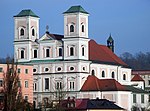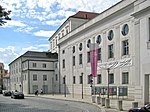Veste Oberhaus
1219 establishments in EuropeBuildings and structures in PassauCastles in BavariaLocal museums in GermanyMuseums in Bavaria ... and 1 more
Thingplatz

Veste Oberhaus is a fortress that was founded in 1219 and, for most of its time, served as the stronghold of the Bishop of Passau, Germany. It is currently the site of a museum, a youth hostel, and a restaurant, as well as an open-air theatre dating to 1934. The fortress is located on the mountain crest (St. Georgsberg) on the left side of the Danube between it and the Ilz, and dominates the old city of Passau, which it faces across the Danube. Below Oberhaus on the promontory between the two rivers is Veste Niederhaus, part of the fortress system.
Excerpt from the Wikipedia article Veste Oberhaus (License: CC BY-SA 3.0, Authors, Images).Veste Oberhaus
Ferdinand-Wagner-Straße,
Geographical coordinates (GPS) Address External links Nearby Places Show on map
Geographical coordinates (GPS)
| Latitude | Longitude |
|---|---|
| N 48.5775 ° | E 13.470277777778 ° |
Address
Veste Oberhaus
Ferdinand-Wagner-Straße
94034 , Ilzstadt
Bavaria, Germany
Open on Google Maps










